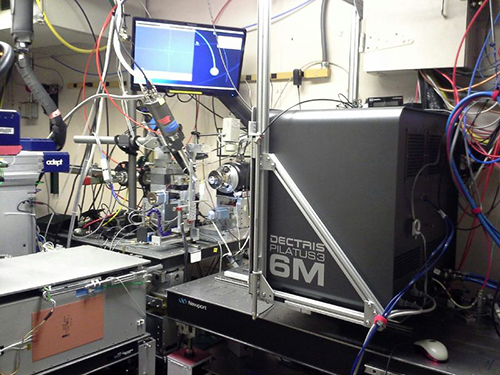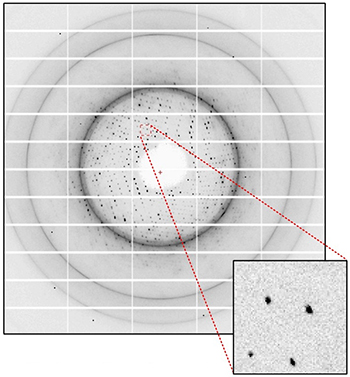X-RAY RUNS: Apply for Beamtime
2017 Nov 1 - Dec 21
2018 Feb 7 - Apr 3
2018 Proposal/BTR deadline: 12/1/17
2018 Apr 11 - Jun 4
2018 Proposal/BTR deadline: 2/1/18
A Pilatus3 6M pixel array detector has replaced the Q-210 CCD detector in the A1 hutch. This is the preferred detector worldwide for macromolecular crystallography, because of its large dynamic range, zero background, very small point spread function, and millisecond readout time.
The fast readout allows data to be collected in “shutterless” mode, meaning that the shutter remains open during a large-angle rotation, e.g. 180°, of the crystal, while the detector records a series of images. This avoids the overhead, mechanical wear, and small inaccuracies in starting and ending points of the many short, small-rotation exposures that must be used with a detector that takes longer to read out.

The X-ray energy at A1 is currently 19.6 KeV (corresponding to a wavelength of 0.63 Å), due to the use of a diamond monochromator and constraints on where the beam must be positioned in the hutch. At this energy, diffraction spots produced by crystals with unit cell dimensions of a few hundred Ångstroms are only a few pixels apart on the detector, even when it is as far back as possible, and the small point spread function of the Pilatus is critically important in preventing strong spots from “blooming” and contaminating neighboring spots.
The first undulator feeding A1 for the beginning of the Fall 2014 run is a 30-cm prototype, which produces much less flux than the 1.5 m device to be installed later in the run, and the X-ray beam coming off the monochromator is currently unfocused. Hence the beam through the A1 collimator is weaker than it was in the past and will be in the future, and the zero background due to the detector is advantageous in detecting the weak diffraction from small and/or poorly ordered crystals.
The figure shows diffraction from a crystal of moderate quality, collected by the first outside user of the new A1 setup. An entire 400-image data set was collected in 7 minutes. Processing statistics were as expected for this type of crystal. Once a longer undulator is in use, data collection times will drop even further.

- Some improvements remain for the future:
- Focusing of the beam, to increase flux through the collimator.
- Software updates to handle beam interruptions more smoothly.
- Hardware modification to allow longer crystal-detector distances.
- Possibly, use of a cryocooled silicon monochromator, which would lower the X-ray energy and reduce spot overlaps.
With these improvements, A1 will be competitive with advanced beamlines at other synchrotron sources such as APS.
Submitted by: Marian Szebenyi, MacCHESS, Cornell University
10/31/2014
